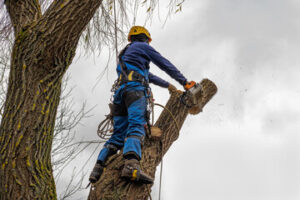Trees and shrubs add beauty to a commercial property and help create a welcoming atmosphere. However, trees require regular care to remain healthy and vibrant.

Professional arborists are skilled at spotting problems such as disease, infestation, and nutrient deficiencies early on. They also prune while the trees are dormant in winter to reduce stress on the tree and promote growth in spring. Contact Lee Tree Service for professional help.
Professional arborists have the expertise and skill to keep trees healthy, enhancing property value and beauty. They use their extensive knowledge of arboriculture to provide preventive and emergency tree care services, such as structural pruning, pest and disease management, and emergency storm damage cleanup.
Trees are living investments, and good tree service increases their lifespan and enhances their visual appeal. They also contribute to a property’s overall value by lowering summer cooling costs and winter heating bills, as well as providing monetary benefits from their monetary value. When choosing a tree service provider, check their credentials and reputation to ensure you are hiring the best in the business.
An ISA Certified Arborist is someone who has undergone extensive training and passed a rigorous exam to become knowledgeable in the field of arboriculture. They have the skill, knowledge, and experience to manage and protect the health and beauty of trees in residential, commercial, and public properties.
In addition to assessing the health of your trees, an arborist will identify potential hazards. For instance, improper or routine pruning can cause a tree to weaken or fail in the event of a storm, resulting in damaged limbs and fallen trunks that pose a safety risk. Proactive pruning promotes a balanced weight distribution, reduces the risk of structural failure, and can help a tree withstand storms.
Before beginning any work, the arborist will conduct a thorough walkthrough and assessment of your property’s trees. They will look for any visible signs of distress, including discolored or wilting leaves, early leaf drop, and unusual growth patterns. They will also inspect the trunk and branches closely for cracks, cavities, fungi, and other issues that may indicate an underlying problem.
Once the inspection is complete, the arborist will make recommendations and propose a course of action for your trees. They will also give you an estimate of the cost and timeline for their services. Once you’ve consulted with an arborist, be sure to compare estimates from several tree service providers to find the best price and value. Before the tree service team arrives, you should make sure they have unhindered access to the affected area. If you have locked gates or fences, they will need to know ahead of time so that they can make arrangements to unlock them.
Safety Concerns
Trees can be a beautiful addition to any property, but when they’re diseased or in poor condition they can pose significant hazards. Whether it’s damaging nearby structures or blocking clear sightlines, unsafe trees require prompt removal to protect the safety of individuals and property alike. This is especially true after severe storms, when unstable or decaying trees can fall and cause damage.
Professional arborists are trained to evaluate the condition of trees and recommend the most appropriate course of action. This may include pruning, trimming, or felling. However, even with proper training, there are still some serious safety concerns to consider.
Some of the most common risks involve power lines and heights. Arborists working at great heights must pay special attention to their environment, using a spotter to assist in communication and ensuring that all equipment is secured. They must also follow a safe distance policy when working near live power lines, staying at least twice the length of the cord away from them. In addition, there are often underground utility cables present when working on a tree, which can add an element of danger.
Working in the field can also expose workers to toxic fumes produced by chainsaws and other power tools, which is why specialized respiratory protection is essential. Moreover, falling limbs can strike workers or bystanders on the ground, and improper use of equipment can result in dangerous accidents.
In addition, navigating around trees and climbing them requires specialized knowledge of tree biology and physics. For example, safely felling a tree involves determining the correct drop zone and making precise cuts. Untrained homeowners who attempt to cut down their own trees without these precautions can put themselves and others at risk of injury or death.
The most serious risk is the possibility of contacting an overhead power line. Every year, amateur tree workers are injured or killed by contact with electrical wires through their tools and falling limbs. Professionals know how to mitigate this hazard by de-energizing the area and maintaining safe distances from power lines with a spotter, as well as by using control lines to guide the movement of falling limbs.
Pests & Diseases
A well-maintained tree adds to the value of your property and provides shade and beauty, but it’s also vulnerable to pest infestations and disease. An expert arborist can help you identify and respond to these issues before they become severe, saving your trees from costly damage or even death.
A few common pests that need to be monitored include small holes in trunks or branches, which indicate the presence of borers; chewed or skeletonized leaves, which are signs of caterpillar or beetle activity; and sticky sap or honeydew on plants, which indicates insect feeding and attracts mold or fungi. A build-up of sawdust or frass around the base of a tree or in branch crotches is another clue that there’s a pest problem.
Tree diseases like Leaf Spot and Powdery Mildew can affect many different species of trees. Regular trimming service, improving air circulation and reducing humidity levels in the canopy, and application of appropriate fungicides are all helpful for controlling these diseases. In addition, planting resistant varieties is an excellent way to prevent a serious outbreak of disease on your property.
There are many other pests and diseases that can impact the health of your landscape, such as emerald ash borer, gillyweed, eastern red cedar rust, and oak wilt. ISA Certified Arborists and Colorado Department of Agriculture licensed pesticide applicators can identify and manage disease considerations in your landscape.
Ultimately, the most effective strategy for combating pests and disease is prevention. Taking simple steps like plant species selection, ensuring the proper soil conditions are present during planting, and utilizing the right fertilizers can minimize your need to use pesticides on your ornamental trees and shrubs. The best strategy is working with an experienced tree service company that offers comprehensive and consistent care, so you can stay on top of pest and disease outbreaks before they threaten the health of your landscape. A good tree service company will offer regular inspections and maintenance, allowing them to detect problems early on when they’re most easily treated. This will keep your trees looking and performing their best.
Aesthetic Appeal
Trees can have a dramatic impact on the aesthetics of your landscape, elevating curb appeal and increasing property value. Well-maintained trees are a focal point in any yard, transforming it into a verdant oasis. They also provide a variety of other benefits, from enhancing the environment to reducing cooling costs and acting as windbreaks in the winter.
Professional arborists offer a variety of services that can enhance the beauty and value of your landscape, including pruning and trimming. Aesthetic pruning focuses on removing branches that are dead or damaged, promoting overall health and vitality. It also involves shaping the tree to achieve a desired form, such as thinning and topping. Both of these techniques can improve the visual appeal of your landscape and are essential to the health of the tree.
Additionally, a professional arborist can help you select the right species of trees for your yard. They can recommend tree varieties that will complement the existing landscape and blend seamlessly with your home. Moreover, they can help you create a custom plan for your property that emphasizes balance and beauty. Their expertise helps ensure that your landscape is well-maintained and aesthetically pleasing year round. Whether it’s adding vibrant color to a tropical palm or strengthening a weakened trunk of a majestic oak, they have the tools and skills needed to bring out the best in your landscape.


